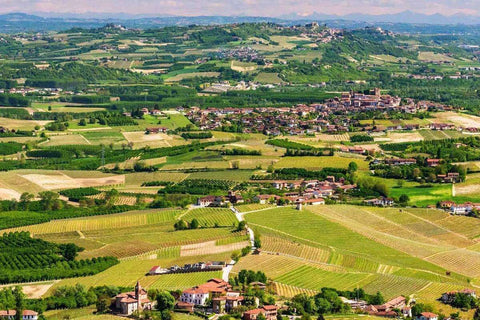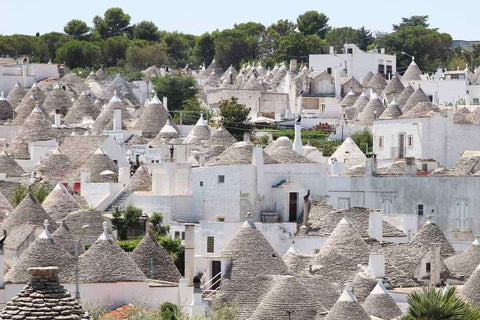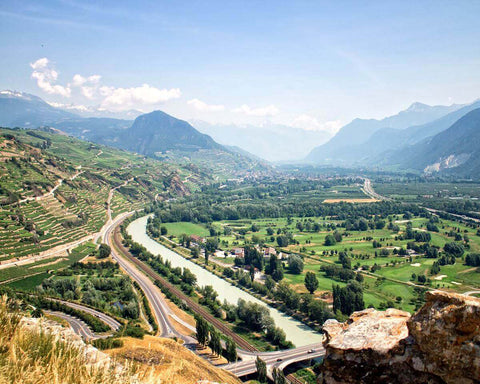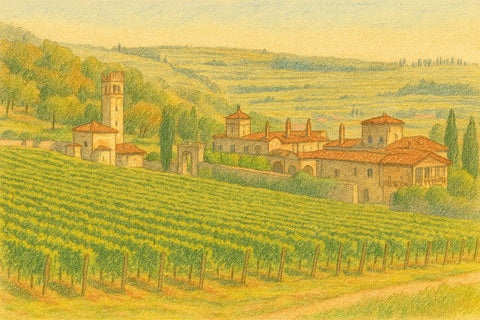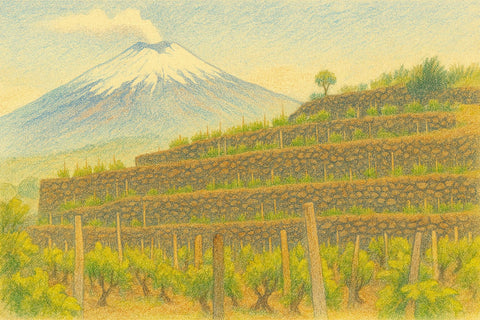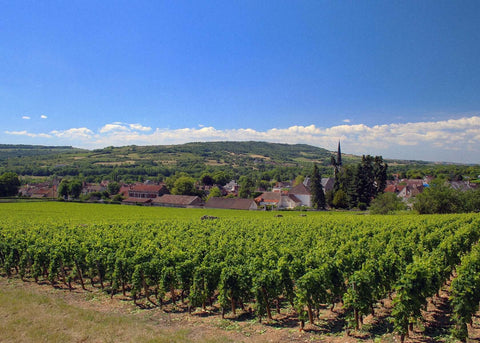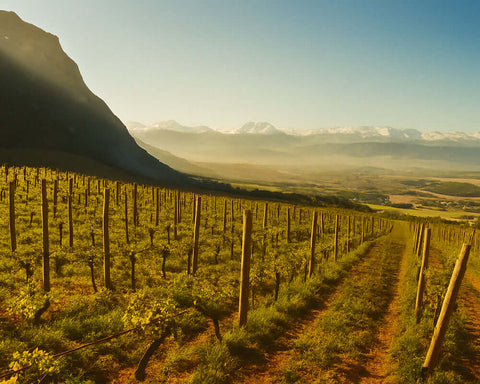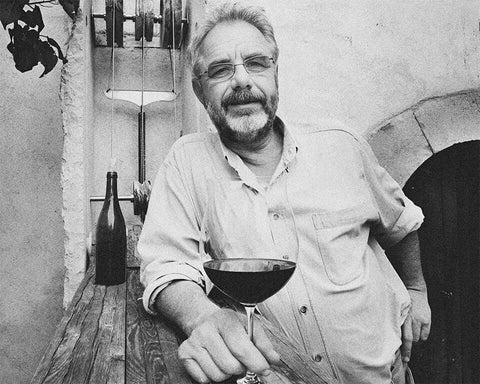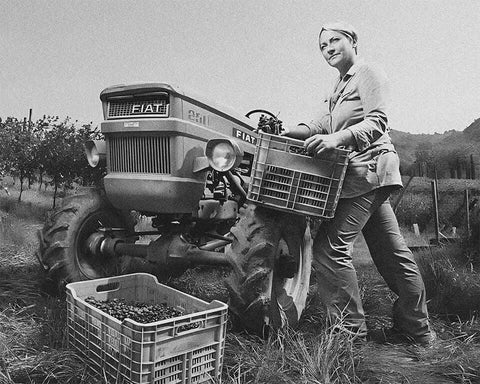Piedmont, translating to "foot of the mountain," stands as one of Italy's most iconic and historically significant wine regions. Nestled in the foothills of the Western Alps, this northwestern Italian gem is revered globally for its intricate tapestry of vineyards, producing wines that embody excellence and tradition.
Over the centuries, Piedmont has emerged as a beacon for organic and natural wine cultivation, with an emphasis on sustainable practices that respect the terroir and the intricate balance of nature.
The wines from Piedmont are not just beverages; they encapsulate the region's rich history, its commitment to quality, and its passionate pursuit of vinicultural perfection, especially evident in its world-renowned Barolo and Barbaresco wines.
Table of Contents
History of Piedmont
Piedmont, bordered by the Alps to the north and west, has always been a region of strategic significance, both geopolitically and viticulturally. Its history is a rich tapestry of cultures, from the ancient Ligurians and Celts to the Romans, who recognized the region's potential for wine production.
Over the centuries, Piedmont underwent numerous transformations, from being a key region in the Kingdom of Lombardy to playing a pivotal role in the unification of Italy in the 19th century.
Turin, the regional capital, became Italy's first capital in 1861. Throughout these historic shifts, one constant remained: Piedmont's unwavering commitment to producing exceptional wines, a tradition passed down through generations.
The history of winemaking in Piedmont stretches back to the ancient Celts and Ligurians, who cultivated vines in the region long before the arrival of the Romans. Archaeological evidence suggests that viticulture was well-established in Piedmont when the Romans arrived in the 2nd century BCE.
The Romans, known for their winemaking prowess, recognized the potential of Piedmont's terroir and further developed viticulture in the region. They introduced advanced techniques and expanded the vineyards, laying the foundation for Piedmont's future as a major wine-producing area.
Following the fall of the Roman Empire, viticulture in Piedmont, as in much of Europe, was preserved and advanced by monastic orders. Monasteries became centers of agricultural knowledge, and monks meticulously maintained vineyards and documented their winemaking practices. The Benedictine and Cistercian orders, in particular, played a significant role in promoting high-quality viticulture.
During the medieval period, the nobility also began recognizing the value of Piedmontese wines. They established vineyards and wineries, contributing to the region's reputation for producing fine wines. The Counts of Savoy, who ruled Piedmont, were instrumental in promoting and protecting the region's viticultural interests.
The Renaissance period marked a significant turning point in Piedmont's winemaking history. During this time, the Nebbiolo grape began to gain prominence. Nebbiolo, named after the fog (nebbia) that often blankets the region's vineyards, became the cornerstone of Piedmont's viticulture. The grape thrived in the Langhe hills, producing wines with remarkable complexity and aging potential.
One of the most notable developments during this period was the emergence of Barolo.
Often referred to as the "king of wines and the wine of kings," Barolo is made exclusively from Nebbiolo grapes and celebrated for its depth, structure, and longevity. The origins of Barolo can be traced back to the early 19th century when Marchesa Juliette Colbert de Maulévrier and Count Camillo Benso di Cavour collaborated with French enologist Louis Oudart to refine the winemaking techniques for Nebbiolo, transforming it into the dry, powerful wine we know today.
The 19th century was a period of innovation and challenges for Piedmont's wine industry. On the one hand, the region saw significant advancements in winemaking techniques. The influence of French enologists and adopting scientific approaches to viticulture improved the quality and consistency of Piedmontese wines.
However, this period was also marked by the devastating impact of phylloxera, a vine-killing pest that ravaged European vineyards. Piedmont was not spared, and many vineyards were destroyed. The crisis prompted a replanting effort, often using American rootstocks resistant to phylloxera, which eventually allowed the region to recover and continue its winemaking traditions.
The early 20th century was challenging for Piedmont, as it was for many European wine regions. The two World Wars and the economic turmoil that followed significantly impacted viticulture. However, the resilience of Piedmont's winemakers shone through as they worked to rebuild and rejuvenate their vineyards.
The mid-20th century marked the beginning of a renaissance for Piedmontese wines. Winemakers began to focus on quality over quantity, adopting modern techniques while respecting traditional methods. This period saw the rise of notable wine families and estates, such as Gaja, Giacosa, and Conterno, who played pivotal roles in elevating the status of Piedmont's wines on the global stage.
Piedmont has firmly established itself as one of the world's premier wine regions in recent decades. The region's commitment to quality, combined with its unique terroir, has earned it a place among the elite wine-producing areas of the world.
The appellation system, introduced in the 1960s, further cemented Piedmont's reputation. Creating DOC (Denominazione di Origine Controllata) and DOCG (Denominazione di Origine Controllata e Garantita) classifications helped protect and promote the region's wines. Barolo and Barbaresco, made from Nebbiolo, were among the first to receive DOCG status, underscoring their significance.
Terroir of Piedmont
Piedmont's terroir is characterized by its unique interplay of climate, topography, and soil. The region enjoys a continental climate, with cold winters and warm summers, moderated by the protective embrace of the Alps.
The hilly terrain, particularly in areas like Langhe and Monferrato, provides an optimal setting for vineyards, ensuring ample sunlight and drainage. The soil composition varies, ranging from sandy and clayey in areas like Barolo to more calcareous soils in Barbaresco.
This diverse terroir lends itself to the cultivation of a myriad of grape varieties, each expressing a unique facet of the region's multifaceted character.
The Geology of Piedmont
Piedmont's landscape predominantly comprises rolling hills, with elevations ranging from 150 to 600 meters above sea level. The region is divided into several sub-regions, each with unique geological characteristics. The primary wine-producing areas include Langhe, Roero, and Monferrato, each contributing distinct terroir profiles.
- Langhe: Known for its calcareous marl soils, it provides excellent drainage, which is essential for growing high-quality grapes. The region is famed for Nebbiolo, the grape behind Barolo and Barbaresco, which thrives in the well-drained soils and benefits from the area's significant diurnal temperature variation.
- Roero: Characterized by sandy soils interspersed with clay, Roero is slightly warmer than Langhe. These conditions are ideal for the white grape Arneis, which produces aromatic and fruity wines.
- Monferrato: This area features a mix of clay, limestone, and sandy soils. Monferrato is well-known for its Barbera and Moscato grapes, producing robust red wines and sweet, sparkling wines.
The region's geological diversity ensures that each grape variety can match its optimal soil type, enhancing the grapes' expression and complexity.
Climate and Its Influence
Piedmont's climate is continental, characterized by hot summers and cold winters, with significant temperature variation between day and night. This diurnal range is crucial for grape ripening, allowing the development of sugars during the day and preserving acidity at night. The region's microclimates, influenced by the surrounding Alps and Apennines, further contribute to the distinctiveness of Piedmont wines.
The Grapes of Piedmont
Piedmont has several indigenous grape varieties, each adapted to the region's unique terroir. The most notable are Nebbiolo, Barbera, Dolcetto, Arneis, and Moscato.
Red Grape Varietals
- Nebbiolo: The cornerstone of Piedmont's most celebrated wines, such as Barolo and Barbaresco.
- Barbera: Widely planted and known for its high acidity and bright red fruit flavors.
- Dolcetto: Produces early-drinking wines with soft tannins and fruity flavors.
- Freisa: Known for its spicy and tannic wines.
- Grignolino: Produces light, aromatic wines with notable acidity.
- Ruchè: Aromatic with floral and spicy notes, primarily in Monferrato.
- Brachetto: Used for still and sparkling sweet red wines, such as Brachetto d'Acqui.
- Pelaverga: Rare and known for its light, peppery wines.
- Albarossa: A cross between Nebbiolo and Barbera, producing robust wines.
- Bonarda: Known locally as Bonarda Piemontese, different from Bonarda in other regions.
- Vespolina: Often blended with Nebbiolo for added spiciness and color.
- Uva Rara: Typically blended with other varietals, adding softness and aroma.
- Croatina: Adds color and tannin to blends, often seen in wines from the northern areas.
- Pinot Noir: Grown in small quantities, used in still and sparkling wines.
- Malvasia Nera: Produces sweet and aromatic wines, such as Malvasia di Casorzo.
White Grape Varietals
- Arneis: Known for producing aromatic and crisp wines, primarily in Roero.
- Cortese: The grape behind Gavi wines, known for its acidity and minerality.
- Moscato Bianco: Used to make the famous Moscato d'Asti and Asti Spumante.
- Favorita: Similar to Vermentino, used in fresh and aromatic wines.
- Erbaluce: Known for its high acidity and potential for sparkling and sweet wines.
- Chardonnay: Used both in still wines and for sparkling wine production.
- Sauvignon Blanc: Produces aromatic and crisp wines.
- Riesling: Cultivated in small quantities, used for aromatic white wines.
- Malvasia Bianca: Often used in sweet and aromatic wines.
- Timorasso: Produces full-bodied, complex white wines, primarily in the Tortona hills.
- Nascetta: An ancient varietal making a comeback, known for its aromatic complexity.
- Petit Manseng: Used in small quantities, known for its high acidity and potential for sweet wines.
- Trebbiano: Often blended with other varietals, adds acidity and freshness.
- Pinot Bianco: Used in both still and sparkling wines.
- Pinot Grigio: Produces light and fresh wines.
Top Wines of Piedmont
Barolo: Often referred to as the "King of Wines and Wine of Kings," Barolo is a testament to Piedmont's vinicultural prowess. Made from the Nebbiolo grape, Barolo is characterized by its deep garnet hue, complex aromas of roses, cherries, and truffles, and an aging potential that rivals the world's finest wines.
The wine undergoes extended aging, first in large oak barrels and then in the bottle, resulting in a wine of profound depth, structure, and elegance.
Barbaresco: Barbaresco, while sharing many similarities with Barolo, has its distinct identity. Also crafted from Nebbiolo, Barbaresco wines are known for their finesse and slightly earlier maturation.
The terroir of Barbaresco, with its calcareous soils, imparts a certain elegance to the wines, with notes of red fruits, violets, and spices. While Barbaresco undergoes a shorter aging process compared to Barolo, it still produces wines of remarkable complexity and longevity.
Other Notable Wines: While Barolo and Barbaresco are undoubtedly the crown jewels of Piedmont, the region is also home to other notable wines like Barbera, Dolcetto, and Moscato d'Asti. Barbera, known for its bright acidity and cherry notes, is a versatile wine that pairs well with a variety of dishes.
Dolcetto, translating to "little sweet one," is a fruity wine with soft tannins, perfect for everyday drinking. Moscato d'Asti, a slightly sparkling sweet wine, is known for its fragrant floral and peach aromas, making it a favorite dessert wine.
Cuisine and Typical Products of Piedmont
Piedmont's culinary landscape is as intricate and refined as its wines. The region is famed for its rich and hearty dishes, with a strong emphasis on local and seasonal ingredients.
Truffles, particularly the white truffles of Alba, hold a place of honor in Piedmontese cuisine. Dishes like "Tajarin al Tartufo," thin egg-rich pasta topped with shaved truffles, capture the essence of Piedmont on a plate. Risottos, often infused with Barolo or Barbaresco, showcase the region's affinity for rice dishes.
Piedmont is also known for its cheeses, with Robiola, Gorgonzola, and Taleggio being some of the notable varieties. The culinary traditions of Piedmont, paired with its exceptional wines, offer a gastronomic journey that resonates with the region's rich heritage and passion for excellence. Let's dive deep into Piedmont's cuisine and typical products
Piedmontes Antipasti
In Piedmont, a meal often starts with a selection of antipasti. These appetizers showcase the region's diverse flavors and set the stage for future courses. A typical antipasti spread might include:
- Vitello Tonnato: This classic dish features thin slices of cold, poached veal covered in a creamy tuna sauce. Tender meat and savory sauce are a hallmark of Piedmontese cuisine.
- Carne Cruda all'Albese: Piedmont's version of steak tartare; this dish consists of raw, finely chopped beef seasoned with lemon juice, olive oil, and shaved Parmigiano-Reggiano.
- Pepperoni con Bagna Càuda: Roasted bell peppers served with a warm dip made from anchovies, garlic, and olive oil. The bagna càuda is a beloved Piedmontese sauce that appears in many dishes.
- Insalata di Cardi: A salad made from cardoons, a thistle-like vegetable related to the artichoke. It's often served with a simple dressing of lemon and olive oil.
Piedmontese Primi Piatti (First Courses)
The first course in a Piedmontese meal often features pasta, risotto, or hearty soups. These dishes showcase the region's grains, rice, and seasonal vegetables.
- Agnolotti del Plin: Small, pinched pasta parcels filled with roasted meat or vegetables. They're often served simply with butter and sage or in a light broth.
- Risotto al Barolo: A luxurious risotto cooked with Barolo wine, giving it a deep, ruby color and rich flavor. It's a perfect example of how Piedmontese cuisine incorporates local wines into dishes.
- Tajarin: Thin, egg-rich pasta strands often served with a butter and sage sauce or a hearty meat ragù. The name comes from the Piedmontese dialect and means "cut" or "thin."
- Panissa: A risotto-like dish from Vercelli made with beans, salami, and local rice. It's a hearty, rustic dish that speaks to the region's farming traditions.
Piedmontese Secondi (Second Courses)
Piedmont is known for its high-quality meats, particularly beef from the Piemontese cattle breed. The second course often highlights these prized ingredients.
- Brasato al Barolo: Beef braised in Barolo wine until tender and flavorful. This dish exemplifies the Piedmontese tradition of cooking with wine.
- Bollito Misto: A selection of boiled meats served with various sauces. It's a celebratory dish that showcases different cuts and types of meat.
- Fritto Misto alla Piemontese: Unlike other Italian versions, the Piedmontese fritto misto includes sweet elements alongside savory ones. You might find apple fritters next to breaded veal cutlets.
- Finanziera: A rich stew made with organ meats, mushrooms, and sometimes sweetbreads. It's a dish that speaks to the Piedmontese tradition of using every part of the animal.
Piedmontese Contorni (Side Dishese)
Piedmontese cuisine doesn't neglect vegetables. Many side dishes and salads highlight the region's produce.
- Giardiniera: A colorful mix of pickled vegetables, often including carrots, cauliflower, and bell peppers. It's a tangy accompaniment to rich meat dishes.
- Peperonata: A stew-like dish of slowly cooked bell peppers, onions, and tomatoes. It's often served at room temperature as a side dish.
- Caponata Piemontese: Unlike its Sicilian namesake, the Piedmontese version is a simple dish of fried eggplant dressed with vinegar.
Piedmontese Formaggi (Cheeses)
Piedmont produces some of Italy's most renowned cheeses. A cheese course often follows the main dishes.
- Castelmagno: A semi-hard cheese made from cow's milk (sometimes with small amounts of sheep or goat milk). It has a crumbly texture and intense flavor.
- Robiola di Roccaverano: A soft cheese made from goat's, cow's, or a mixture of both. It has a creamy texture and tangy flavor.
- Gorgonzola: While originating in Lombardy, Piedmont is also a significant producer of this famous blue cheese.
- Toma Piemontese: A semi-hard cow's milk cheese with a mild, slightly sweet flavor. It's often used in cooking and enjoyed on its own.
Piedmontese Dolci (Dessert)
Piedmontese desserts often feature local hazelnuts, chocolate, and seasonal fruits.
- Bonet: A rich chocolate pudding made with amaretti cookies, rum, and sometimes hazelnuts. It's a classic Piedmontese dessert.
- Panna Cotta: While popular throughout Italy, panna cotta is said to have originated in Piedmont. This creamy dessert is often served with fresh berries or caramel.
- Torta di Nocciole: A simple hazelnut cake that showcases the region's prized Tonda Gentile delle Langhe hazelnuts.
- Zabaglione: A light custard made with egg yolks, sugar, and Marsala wine. It's often served with fresh fruit or used as a base for other desserts.
Typical Products of Piedmont
Piedmont's cuisine is based on high-quality local products. Many of these have achieved protected status, ensuring authenticity and traditional production methods.
Hazelnuts: Piedmont's Gold
The Tonda Gentile delle Langhe hazelnut, also known as the Nocciola del Piemonte IGP, is considered one of the finest hazelnuts in the world. These nuts are prized for their delicate flavor and are used in many sweet and savory dishes. They're also a key ingredient in gianduja, a chocolate hazelnut paste precursor to Nutella.
Rice: The Plains' Bounty
Piedmont, particularly the area around Vercelli, is one of Italy's major rice-producing regions. The Riso di Baraggia Biellese e Vercellese DOP is known for its high quality and is used in many traditional risotto dishes.
Cheese: From Mountains to Plains
Piedmont produces a wide variety of cheeses, each reflecting the characteristics of its production area.
- Grana Padano DOP: While also produced in other regions, Piedmont contributes to producing this hard, granular cheese.
- Murazzano DOP: A soft cheese made primarily from sheep's milk in the Langhe area.
- Bra DOP: Named after the town of Bra, this cheese comes in two varieties - hard and soft.
Meat and Charcuterie
Piedmontese meat products are known for their quality and distinctive flavors.
- Crudo di Cuneo DOP: A dry-cured ham produced in the Cuneo province, known for its sweet, delicate flavor.
- Salame Piemonte IGP: A salami characterized by its prominent grain and the addition of red wine in the mixture.
- Mortadella di Prassolo: A lesser-known but delicious mortadella variety from the Alessandria province.
Fruits and Vegetables
Piedmont's varied climate allows for cultivating a wide range of produce.
- Peperone di Carmagnola: Sweet bell peppers from Carmagnola are known for their crisp texture and intense flavor.
- Cardo Gobbo di Nizza Monferrato: A variety of cardoon with a distinctive curved shape, it's a key ingredient in many traditional dishes.
- Mele Renette del Canada: Apples grown in the Alpine valleys, known for their tart flavor and firm flesh.

